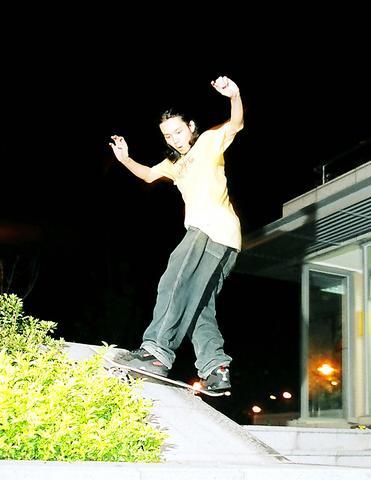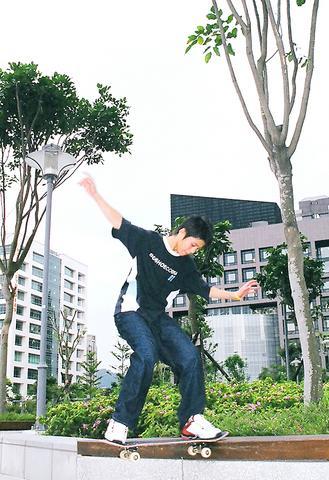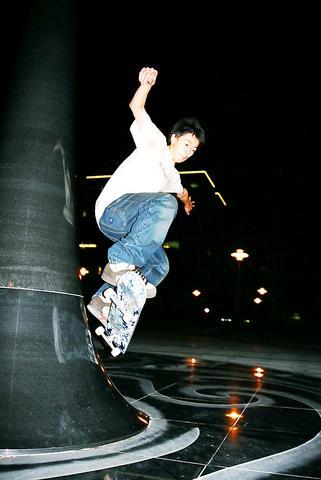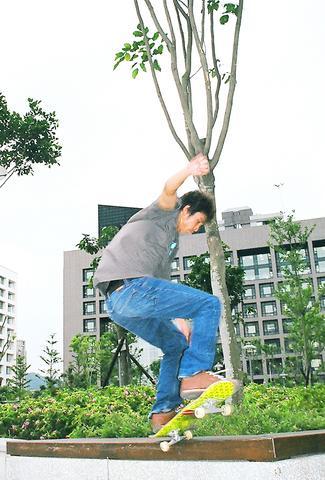Punk band Faction's Skate and Destroy was written in the early 1980's in response to the association of skateboarding with vandalism in North America. While much of the action has been pushed off the streets and into skate parks in other countries, Taiwan remains a skater-friendly spot for local and foreign boarders alike. With a large number of concrete parks and courtyards, and no enforced legislation against using them, Taipei city has a number of ideal locations to ride.
"There are places everywhere. Most of the public parks have perfect rails and ledges to grind. You don't need to go to a skate park to skate in Taiwan," said Paul Clenton, who has been riding here for more than seven years.

PHOTO COURTESY OF JIMMY SUN
The major difference for Clenton, who is used to being banned from skating in public areas in the UK, is the lack of hassle from local authorities. Pointing to a sign outside Zhongshan Hall (

PHOTO COURTESY OF JIMMY SUN
Skateboarding originated in the US in the 1950s with the Roller Derby, a wooden board with clay wheels. It was another 20 years before skating gained marginal popularity, mostly among surfers who would take to the streets and empty pools when the waves were low. Skateboarding, like surfing, was a lifestyle rather than a sport. As time passed it claimed its own niche, separate from surfing, and rare was the day that a skater would be caught with out his or her deck.
A few American films formed initial interest in Taiwan during the mid-1980s and, much like the US, the majority of those who took up the sport were surfers, said Jimmy Sun (

PHOTO COURTESY OF JIMMY SUN
What started as a small shop to provide him and his cronies with quality gear has grown into three stores and the largest distribution of decks in Taiwan. Now with a Mandarin Web site and magazine, Sun is more interested in establishing a skater culture.

PHOTO COURTESY OF JIMMY SUN
Contrary to the number of people donning skate rags, he said the actual percentage of boarders is dropping. His three stores combined sell an average of 30 boards to beginners a month, but he estimates less than three will keep with it. Trying to increase the interest among Taipei's youth, Sun's employees are now offering lessons to beginners.
Clenton said two years ago 50 or more skaters would be at Zhongshan Hall on a Saturday. Last weekend, on a warm, clear afternoon, there were less than 10. The peaks and valleys in skateboarding's popularity exist everywhere, but additional obstacles like high school examinations and mandatory military service account for some of the consistently low number of riders in Taiwan.

PHOTO COURTESY OF JIMMY SUN
Seen as being more of a sport than a lifestyle, skateboarding has never been viewed as a viable means of transportation in Taiwan, for reasons ranging from unruly traffic to laziness.
In the mid-1990s, when extreme sports were popularized with the help of the Asian X-games, skateboarding became a quick fix for teenagers looking for some excitement. With visions of cash and prizes grinding in their heads, many saw skateboarding as a get-cool-quick scheme, but it didn't always pan out.
"A lot of young kids start because they want to compete. They're only interested in learning tricks. If they don't win they lose interest. What they don't understand is that some of the best skaters in the world have never been to a competition," Sun said.
David Lin (
Where someone skates depends on whether it's street skating, in which case almost any one of Taipei's public parks are skate-able. Or, if its vert-ramps and half pipes then there are a few skate parks in Taipei city and county.
Constructed five years ago for in-line skating, BMX and skateboarding, the Extreme Sports Park in Yuanshan looks as though it needs resurfacing. Funded by the city government the park was built by a private construction company which, according to people who use the facility regularly, has yet to fix any of the broken ramps.
Contrary to popular assumptions, picking up a board after a hiatus of several years, isn't as difficult as it looks. Starting out or getting back into skateboarding can be costly, but Taipei has a handful of professional, well-stocked skate shops with informed staff.
Those afraid of a little road rash, but who enjoy watching should head to one of the public courtyards or skate parks in the early evening. There are also open competitions held nearly every month.
Additional places to skate and shop as well as dates for upcoming competitions in Taipei are available online at www.slick.com.tw.
For information on skate lessons contact Jimi Skate Shop at 23, Guangfu S Rd, Ln 346, Taipei (北市光復南路346巷23號). Call (02) 2731 1413.
Where to Kiss the Pavement:
Public Areas
1) Zhongshan Hall (中山堂): 98 Yenping S Rd, Taipei (台北市延平南路98號)
2) Tianmu Dong He Park (天母東和公園): 141 Zhongshan North Road Sec. 7, Tianmu, Taipei (台北市天母)
3) Taipei 101 Park, (台北101大樓 公園): 21, Xinyi Rd, Sec. 1, Taipei (台北市信義路一段21號)
Skate Parks
1) Extreme Sports Park in Yuanshan (極限公園): Across from Yuanshan MRT near Taipei Fine Arts Museum (台北美術館對面)
2) TaiMall Park (台茂): B2, 112, Nankan Rd. Sec. 1, Luzhu, Taoyuan, Taipei County (台北縣盧竹鄉南崁路一段112號B2)
3) Shulin Extreme Sports Park (樹林體極限運動場): 81, Shuiyuan St, Shulin City, Taipei County (北縣樹林市水源街81號).

Taiwan Power Co (Taipower, 台電) and the New Taipei City Government in May last year agreed to allow the activation of a spent fuel storage facility for the Jinshan Nuclear Power Plant in Shihmen District (石門). The deal ended eleven years of legal wrangling. According to the Taipower announcement, the city government engaged in repeated delays, failing to approve water and soil conservation plans. Taipower said at the time that plans for another dry storage facility for the Guosheng Nuclear Power Plant in New Taipei City’s Wanli District (萬里) remained stuck in legal limbo. Later that year an agreement was reached

What does the Taiwan People’s Party (TPP) in the Huang Kuo-chang (黃國昌) era stand for? What sets it apart from their allies, the Chinese Nationalist Party (KMT)? With some shifts in tone and emphasis, the KMT’s stances have not changed significantly since the late 2000s and the era of former president Ma Ying-jeou (馬英九). The Democratic Progressive Party’s (DPP) current platform formed in the mid-2010s under the guidance of Tsai Ing-wen (蔡英文), and current President William Lai (賴清德) campaigned on continuity. Though their ideological stances may be a bit stale, they have the advantage of being broadly understood by the voters.

In a high-rise office building in Taipei’s government district, the primary agency for maintaining links to Thailand’s 108 Yunnan villages — which are home to a population of around 200,000 descendants of the Chinese Nationalist Party (KMT) armies stranded in Thailand following the Chinese Civil War — is the Overseas Community Affairs Council (OCAC). Established in China in 1926, the OCAC was born of a mandate to support Chinese education, culture and economic development in far flung Chinese diaspora communities, which, especially in southeast Asia, had underwritten the military insurgencies against the Qing Dynasty that led to the founding of

Artifacts found at archeological sites in France and Spain along the Bay of Biscay shoreline show that humans have been crafting tools from whale bones since more than 20,000 years ago, illustrating anew the resourcefulness of prehistoric people. The tools, primarily hunting implements such as projectile points, were fashioned from the bones of at least five species of large whales, the researchers said. Bones from sperm whales were the most abundant, followed by fin whales, gray whales, right or bowhead whales — two species indistinguishable with the analytical method used in the study — and blue whales. With seafaring capabilities by humans